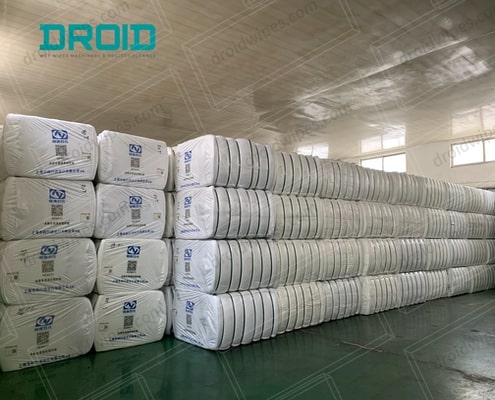1. Customized Maintenance Schedule
An individualized maintenance program is crucial for guaranteeing the durability and peak efficiency of your wet wipes manufacturing unit. A customized maintenance plan takes into account the unique requirements and use patterns of your equipment, rather than using a generic approach. This customized approach starts with a comprehensive evaluation of the machine’s operating history and present state. To accurately plan maintenance, it is important to determine the frequency and circumstances in which the equipment is used, as this can help identify possible areas of wear and tear. By adopting a proactive strategy, one may effectively tackle small issues before they grow into big ones, resulting in a reduction of unplanned downtime and expensive repairs.
Utilizing predictive maintenance solutions may optimize the efficiency of your tailored timetable. These technologies use data analytics and machine learning algorithms to continuously monitor the equipment in real-time. Strategically positioned sensors monitor key components, measuring characteristics such as temperature, vibration, and pressure, which provide crucial information about the machine’s condition. When these measures differ from the usual standard, the system can anticipate possible breakdowns and notify operators to carry out essential maintenance. Servicing each component at the right moment, not only eliminates surprise malfunctions but also prolongs the lifetime of the equipment.
Furthermore, implementing a tailored maintenance plan promotes a culture of ongoing improvement. Frequently evaluating and revising the maintenance plan in response to comments and new data helps in improving the process. This iterative technique guarantees that the schedule stays relevant and efficient as the production environment and operational needs change. Furthermore, including operators in the maintenance planning process may result in improved compliance with the schedule and a more proactive approach to equipment repair. In the end, a properly maintained machine function with more efficiency generates an output of superior quality and enhances worker safety and productivity.
2. Operator Training and Certification
Operator training and certification are essential components in optimizing the performance of your wet wipes manufacturing line. Proficient operators possess a profound comprehension of the equipment they operate, resulting in enhanced efficiency and safety throughout operations. Thorough training programs should include all facets of machine operation, ranging from fundamental capabilities to sophisticated troubleshooting approaches. This guarantees that operators are adequately prepared to deal with any potential circumstances that may occur during production, hence reducing the amount of time that operations are halted and ensuring a consistent and uninterrupted workflow.
Investing in operator certification programs not only improves individual skills but also fosters professionalism and responsibility. Operators who have obtained certification are more inclined to adhere to established guidelines and safety procedures, hence reducing the likelihood of accidents and equipment damage. Certification programs often include standardized examinations that verify the operator’s knowledge and abilities, establishing a baseline for evaluating performance. This not only enhances the operators’ confidence but also ensures management of their ability to successfully manage the production line.
Incorporating regular training sessions into an ongoing growth plan is more beneficial than treating it as a singular occurrence. The wet wipes manufacturing sector is continuously advancing with the introduction of innovative technology and processes. Ensuring operators are regularly educated on the newest innovations is crucial for maintaining exceptional operating standards. Practical workshops, hands-on training, and simulation exercises have the potential to greatly enhance the learning process, allowing operators to immediately apply newly acquired skills to their work environment. Furthermore, cultivating a culture that promotes continuous learning and growth motivates operators to remain actively involved, thus making a favorable impact on overall productivity.
Moreover, including operators in the training design process may result in superior results. Incorporating real-life situations into the training curriculum enhances the relevance and impact of the learning experience by addressing the everyday issues faced by individuals. Operators’ feedback may be used to pinpoint areas that need more training, guaranteeing that the program focuses on practical demands rather than abstract ideas. The collaborative approach not only improves the efficacy of the training but also empowers operators, enabling them to actively contribute to the efficiency and success of the production line.
3. Optimize Wet Wipes Raw Material Quality
Enhancing the quality of wet wipes raw materials is a crucial element in increasing efficiency in the manufacturing process of wet wipes. Utilizing superior raw materials enhances operational efficiency and plays a crucial role in maintaining the uniformity and dependability of the final product. Inferior materials may result in frequent machine jams, heightened waste, and subpar end products, all of which have a detrimental effect on production efficiency. By procuring high-quality wet wipes raw materials, you reduce these risks and provide a more consistent and predictable manufacturing setting.
To optimize the quality of wet wipes raw materials, it is crucial to have strong and dependable connections with trustworthy suppliers. Regular and ongoing contact, as well as frequent inspections of suppliers’ facilities, may assist in guaranteeing their adherence to the highest quality requirements. Engaging in negotiations for extended contractual agreements with reliable suppliers not only guarantees a consistent supply of superior materials but also often leads to more favorable pricing and preferential treatment. In addition, expanding the range of suppliers you work with may serve as a precautionary measure against any delays in the supply chain. This helps to ensure that production remains uninterrupted, even if one supplier has difficulties.
Conducting regular quality inspections and implementing stringent testing procedures for wet wipes raw materials upon their arrival is crucial for maintaining high standards. Enforcing a rigorous quality control routine aids in detecting any inferior materials before their inclusion in the manufacturing process. Utilizing sophisticated analytical equipment and procedures allows for the evaluation of the physical and chemical characteristics of the materials, guaranteeing their compliance with the necessary criteria. By identifying possible problems at an early stage, you may prevent expensive delays in production and ensure the reliability of your manufacturing process.
Allocating resources towards superior raw materials may seem to involve a greater initial expenditure, but it ultimately yields benefits in the long term by improving efficiency and minimizing operational complications. High-quality wet wipes raw materials often result in increased production rates, as the equipment can process them more effectively, minimizing the need for frequent pauses and modifications. This not only enhances the rate of production but also diminishes the damage and deterioration of the machinery, hence prolonging its life and decreasing the expenses associated with maintenance. In addition, the use of high-grade wet wipes raw materials plays a significant role in the manufacturing of exceptional final goods, which may be sold at premium rates in the market and improve the image of your business.
Ultimately, by continuously improving and innovating in the procurement of wet wipes raw materials, you may further enhance and streamline your manufacturing process. Keep yourself updated on the latest materials and innovations in the industry that may provide improved performance or cost-effectiveness. Engage in cooperation with suppliers to create personalized materials that are specifically designed to meet your unique manufacturing requirements. By always striving to improve the quality of wet wipes raw materials, you ensure that your manufacturing line remains at the forefront of efficiency and excellence.
4. Implement Advanced Monitoring Systems
Implementing advanced monitoring systems is a critical step towards achieving peak efficiency in your wet wipes production line. These systems utilize state-of-the-art technology to provide real-time data and analytics on the performance of your equipment, allowing for proactive management and swift responses to any issues that arise. By continuously monitoring key parameters such as machine speed, output rates, temperature, pressure, and vibration levels, these systems can help identify inefficiencies and potential failures before they become significant problems.
Advanced monitoring systems work by integrating various sensors and IoT (Internet of Things) devices throughout the production line. These sensors collect data continuously, which is then transmitted to a central control system. Here, sophisticated algorithms analyze the data to detect patterns and anomalies. For example, if a sensor detects an unusual vibration that could indicate a bearing is about to fail, the system can alert operators immediately, allowing them to address the issue before it leads to a costly breakdown. This predictive maintenance capability is one of the key benefits of advanced monitoring systems, as it minimizes unplanned downtime and extends the lifespan of your equipment.
Another advantage of advanced monitoring systems is their ability to enhance overall productivity by optimizing operational parameters. The data collected can be used to fine-tune machine settings for optimal performance, such as adjusting speeds and feeds to match the quality and consistency of raw materials. This level of precision ensures that each batch of wet wipes is produced efficiently, with minimal waste and maximum output. Additionally, these systems can generate detailed reports and dashboards that provide valuable insights into production trends, helping wet wipes manufacturers make informed decisions to further improve efficiency.
Furthermore, the implementation of advanced monitoring systems contributes to better quality control. By tracking and recording data at every stage of the production process, these systems ensure that any deviations from the standard are immediately identified and rectified. This not only maintains the high quality of the final product but also reduces the likelihood of recalls and customer complaints. Consistently producing high-quality wet wipes can enhance your brand’s reputation and lead to increased customer satisfaction and loyalty.
The adoption of advanced monitoring systems also promotes a safer working environment. By monitoring critical parameters and providing early warnings of potential hazards, these systems help prevent accidents and protect workers. For example, if a machine is overheating or if there is an unusual pressure build-up, the system can trigger an automatic shutdown or alert operators to take corrective action. This proactive approach to safety ensures that your production line operates smoothly and without incidents.
In conclusion, investing in advanced monitoring systems is a strategic move that offers numerous benefits, including improved efficiency, enhanced quality control, reduced downtime, and increased safety. By leveraging real-time data and analytics, you can ensure that your wet wipes production line operates at its best, delivering high-quality products consistently and cost-effectively.
5. Regular Calibration and Upgrades
Consistent calibration and prompt updates are crucial procedures for preserving the effectiveness and precision of your wet wipes manufacturing equipment. Over time, even the most sophisticated equipment may undergo drift in its settings and wear in its components, resulting in reduced performance and possible quality problems. Regular calibration guarantees that the equipment functions within the set tolerances, preserving the accuracy required for high-quality manufacturing.
Calibration entails the fine-tuning of the wet wipes machine’s sensors and control systems to synchronize with established reference points. This procedure guarantees the precision of measures such as speed, pressure, and temperature, which is essential for maintaining constant product quality. For example, minor variations in cutting processes might cause wipes to be the wrong size, while imprecise dosing systems can result in variances in moisture levels. Regularly calibrating these systems may avoid such difficulties, guaranteeing that every batch of wet wipes complies with the necessary criteria.
Ensuring the competitiveness and efficiency of your operations requires the equally critical task of upgrading your equipment. Technological progress in the sector may provide substantial enhancements in speed, dependability, and usefulness. Software upgrades provide more functionalities, improved user interfaces, and increased compatibility with other systems. Possible hardware changes may include the installation of more proficient motors, enhanced control panels, or cutting-edge sensors. These enhancements may result in significant improvements in productivity and efficiency, as well as advanced features such as improved energy efficiency or decreased maintenance requirements.
Furthermore, adopting a proactive strategy for calibration and updates will effectively prolong the life of your equipment. Regular calibration facilitates the early detection of wear and tear, enabling proactive maintenance to prevent small problems from escalating into significant failures. This not only decreases the amount of time that a system is not operational but also lowers the expenses related to urgent repairs and replacements. By regularly updating your equipment with the most recent technology, you may avoid obsolescence and maintain the viability and efficiency of your production line for a longer duration.
Executing a methodical timetable for calibration and updates necessitates synchronizing with equipment manufacturers and service providers. Several wet wipes manufacturers provide calibration services and may advise on the most suitable frequency depending on use patterns and environmental circumstances. Maintaining a comprehensive record of all calibration and upgrade procedures is also advantageous. This record facilitates the monitoring of the machine’s operation over time and enhances the efficiency of future maintenance planning.
Providing training to your employees on the significance of calibration and the proper execution of fundamental calibration duties will further improve the efficiency of this activity. Operators who understand the significance of accurate configurations on product excellence are more inclined to comply with calibration timetables and swiftly notify of any inconsistencies. Likewise, informing people about the advantages of updates, guarantees that they are open to changes and can readily adjust to new systems and features.
Ultimately, it is crucial to regularly calibrate and promptly update wet wipes machines to maintain their efficiency and accuracy. These methods aid in maintaining superior product quality, minimizing operational interruptions, and prolonging the lifetime of equipment, all of which enhance the productivity and cost-efficiency of the production line. To maintain a leading position in industry standards, it is important to be proactive and well-informed about the newest technical breakthroughs.
6. Energy Efficiency Practices
Implementing energy efficiency strategies is essential for decreasing operating expenses and mitigating the environmental consequences of your wet wipes manufacturing process. Implementing energy-efficient strategies not only reduces your utility expenses but also improves the sustainability of your operations, providing a notable edge in today’s environmentally sensitive market. By using a methodical and well-planned approach to energy management, you may enhance the efficiency and effectiveness of your machines, while also making a positive impact on the environmental sustainability of your production process.
Conducting an energy audit of your industrial plant is a crucial first step in enhancing energy efficiency. An energy audit is a process that helps identify areas where energy is being inefficiently used and provides a starting point for assessing improvements. The audit should include a comprehensive review of all energy-consuming equipment, including manufacturing machinery, lighting, heating, and cooling systems. By comprehending your energy use patterns, you may formulate focused tactics to decrease consumption without sacrificing the quality or output of manufacturing.
Another efficient method to improve energy efficiency is by upgrading to energy-efficient equipment. Contemporary wet wipes manufacturing machines include cutting-edge technology that minimizes energy consumption without compromising or even enhancing performance. Energy-efficient motors and drives can greatly decrease power consumption. Furthermore, the integration of variable frequency drives (VFDs) may enhance motor speed based on the production load, resulting in energy conservation during times of low demand. Allocating funds for these improvements may need an initial expenditure, but the subsequent reduction in energy consumption may compensate for these costs and provide a good return on investment in the long run.
Integrating energy management systems (EMS) may enhance your efforts to enhance energy efficiency. An Energy Management System (EMS) provides real-time monitoring and control of energy use, enabling the identification of inefficiencies and prompt modifications. These systems can automatically turn off equipment when they are not in use or adjust lighting and HVAC systems according to occupancy and production schedules. An Energy Management System (EMS) provides valuable information that allows you to adjust and optimize your energy use patterns throughout the manufacturing process.
Efficient energy use is greatly influenced by optimizing the physical arrangement of your manufacturing facility. Optimizing the layout of machines and workstations to limit the distance traveled by materials and products may result in a reduction in energy consumption for material handling and transportation. An effective layout design may enhance ventilation and natural illumination, hence decreasing the need for artificial lighting and air conditioning. Performing routine maintenance on equipment, including tasks like cleaning filters and maintaining adequate lubrication, may help avoid energy losses caused by friction and resistance, thus improving overall energy efficiency.
Employee participation is crucial for the effective adoption of energy efficiency techniques. Providing instruction to employees on the significance of energy preservation and engaging them in efforts to reduce energy use helps establish a sustainable mindset within your company. Implementing simple actions, such as promoting the practice of operators switching off machinery and lights when not in use or promptly reporting instances of energy-wasting, may have a substantial cumulative impact. Offering rewards for energy-conserving concepts and behaviors might also stimulate workers to actively engage in energy management initiatives.
Ultimately, the investigation of renewable energy sources may enhance and support your efforts to improve energy efficiency. By implementing solar panels or wind turbines, one may produce renewable energy directly at the location, hence decreasing reliance on traditional energy sources and reducing their carbon impact. Although the initial cost of investing in renewable energy infrastructure may be significant, the availability of government subsidies and the potential for long-term energy savings make it a feasible choice for several manufacturing facilities.
To summarize, incorporating energy-saving measures into your wet wipes manufacturing process requires a comprehensive strategy that includes modernizing machinery, improving facility design, using sophisticated management systems, and involving personnel. By decreasing energy use, you not only save operating expenses but also contribute to a more sustainable and eco-friendly manufacturing process. Adopting energy efficiency may improve your brand’s image and link your operations with worldwide sustainability objectives, giving you a competitive advantage in the market.
7. Streamlined Workflow Layout
An optimized workflow structure is crucial for increasing the productivity of your wet wipes manufacturing line. By strategically arranging equipment, workstations, and storage places, you may limit the distance that materials and products need to travel, decrease the time spent on handling, and avoid any obstacles that may slow down the process. This strategy not only enhances the speed of production but also enhances safety and decreases operating expenses.
To establish a simplified workflow architecture, the first step is to meticulously outline the complete production process, including all stages from initiation to completion. This entails the identification of every stage in the manufacturing process of wet wipes, starting from the storage and processing of wet wipes raw materials to the ultimate packing and shipping. By comprehending the movement of resources and goods throughout your plant, you may pinpoint locations where enhancements might be implemented. For instance, in cases where wet wipes raw materials need transportation across significant distances inside the facility, reorganizing storage facilities to be in closer proximity to the first processing stations may result in time savings and a decrease in the likelihood of damage.
After the workflow has been delineated, the subsequent action is to organize the equipment and workstations in a coherent order. To provide a seamless and uninterrupted flow, machines should be arranged in the sequence of the manufacturing process. For example, positioning cutting and folding machines near the area where wet wipes raw materials are prepared may decrease the time it takes to move materials and make operations more efficient. In addition, placing packing machinery towards the end of the manufacturing line guarantees the fast and effective packaging and transportation of completed goods to storage or shipment zones.
Optimizing the layout also entails taking into account the ergonomics and safety of the workstation. Workers should be provided with convenient access to their equipment and supplies, eliminating the need for excessive reaching, bending, or walking lengthy distances. This minimizes physical exertion and exhaustion, hence improving efficiency and decreasing the likelihood of work-related accidents. Establishing unobstructed routes and assigned spaces for equipment and supplies contributes to the maintenance of a well-ordered and productive work setting. Implementing safety precautions, such as enough illumination, slip-resistant flooring, and prominently labeled emergency exits, enhances the efficiency and security of operations.
Integrating automation into the design may greatly improve the efficiency of the process. Automated conveyor systems, robotic arms, and automated guided vehicles (AGVs) are capable of doing monotonous activities such as transporting materials, stacking products, and packing. Automated systems not only enhance production efficiency but also guarantee uniformity and minimize the probability of human mistakes. Incorporating automation into the layout requires meticulous design to guarantee that automated systems do not disrupt human processes and that there is enough room for maintenance and modifications.
Consistently evaluating and revising the arrangement of the workflow is essential for preserving its efficiency. As the requirements for production change and new technologies emerge, it is necessary to modify the layout to align with these advancements. Engaging workers in the review process may provide significant ideas for implementing practical improvements. Operators and maintenance workers, who have regular interaction with the equipment, can recognize inefficiencies and propose modifications that management may fail to see. Incorporating their comments guarantees that the design maintains its practicality and efficiency.
Ultimately, implementing a simplified workflow architecture is a smart method for improving the efficiency and productivity of your wet wipes manufacturing line. By strategically organizing the placement of equipment and workstations, integrating automation, and consistently evaluating the layout, one may establish a streamlined, secure, and effective production process. This not only enhances efficiency and decreases expenses but also adds to a more structured and pleasant work atmosphere for your staff.
8. Utilize Automation and Robotics
Incorporating automation and robots into your wet wipes manufacturing line may significantly improve efficiency, uniformity, and output. Through the automation of repetitive and labor-intensive operations, the occurrence of human error may be minimized, while production can be maximized, resulting in a more efficient and dependable wet wipes manufacturing process. The integration of automation and robotics may be implemented throughout different stages of production, starting with the handling of wet wipes raw materials and extending to the final packing. This integration provides a multitude of advantages to your operations.
An inherent benefit of automation is its capacity to function at accelerated velocities and with enhanced accuracy compared to manual work. Automated machines and robotic systems can execute operations like cutting, folding, and packing wet wipes with unwavering precision and rapidity, a level of performance that human operators may struggle to sustain over extended durations. By maintaining consistency, every product is held to the same rigorous standards of quality, minimizing the probability of faults and enhancing customer satisfaction.
Integrating robots into your manufacturing line may enhance safety by reducing the need for human workers to carry out hazardous or physically strenuous jobs. Robots are capable of doing tasks that include heavy lifting, repeated actions, and exposure to potentially dangerous substances, hence minimizing the likelihood of workplace accidents. This not only enhances workplace safety but also allows your human workers to dedicate their efforts to more intricate and strategic jobs that need critical thinking and problem-solving abilities.
Another notable advantage of automation and robots is the capacity to function constantly with minimum periods of inactivity. Automated systems can operate continuously for 24 hours a day, 7 days a week, resulting in a substantial boost in production capacity and a decrease in lead times. Scheduling maintenance during planned downtimes and using predictive maintenance technology may help monitor the state of robotic systems and notify operators of possible concerns before they lead to interruptions. By using this proactive maintenance method, you can ensure the continuous operation and optimal performance of your manufacturing line.
Furthermore, the use of automation and robots may improve the capacity of your manufacturing process to be easily adjusted in size and adapt to changing circumstances. Automated systems may be readily adapted to handle variations in production numbers, product standards, and even diverse product lines. The adaptability is especially advantageous in the wet wipes sector, as it allows producers to easily transition between various kinds of wipes or package arrangements to fulfill market requirements. Robotic systems provide the capability to be swiftly reprogrammed and reconfigured, enabling a smooth and uninterrupted shift between various production demands.
By incorporating cutting-edge technology like artificial intelligence (AI) and machine learning (ML), the efficiency of automated systems may be significantly enhanced. Artificial intelligence (AI) and machine learning (ML) algorithms can evaluate production data in real-time. They can detect and recognize patterns and trends within the data, which may then be used to optimize and improve operational processes. AI-powered robots can adjust to fluctuations in wet wipes raw materials or alterations in manufacturing settings, constantly enhancing their activities to maintain efficiency and quality. These intelligent systems may also provide useful insights for ongoing enhancement, aiding in the identification of areas for more optimization and innovation.
Introducing automation and robotics necessitates an initial expenditure on machinery and education, but the long-term advantages significantly surpass these expenses. The enhanced efficiency, decreased labor expenses, and enhanced product quality all contribute to a good return on investment. Moreover, the capability to continually generate a greater output at a faster rate might provide fresh market prospects and enhance your competitive edge.
To effectively incorporate automation and robots into your production line, it is essential to collaborate with experienced suppliers and consultants who can provide the required knowledge and assistance. These collaborators may assist you with choosing the appropriate equipment, creating the most efficient arrangement, and instructing your personnel on how to run and uphold the new systems. Their assistance guarantees a seamless transition and optimizes the advantages of your investment in automation.
To summarize, using automation and robots in your wet wipes manufacturing line provides substantial benefits in terms of effectiveness, security, expandability, and excellence. By using automation for repetitive operations and incorporating cutting-edge technology, you may improve your production capacities, save operating expenses, and maintain a competitive advantage in the market. Adopting automation is a strategic decision that may lead to enduring success and sustainability for your manufacturing operations.
9. Regular Feedback and Continuous Improvement
Consistent feedback and a dedication to ongoing improvement are fundamental elements of an effective and profitable wet wipes manufacturing process. By implementing a methodical strategy for collecting, evaluating, and responding to feedback, you can cultivate a dynamic production environment that consistently develops and improves. By adopting this proactive strategy, you can guarantee the efficiency of your manufacturing processes, the high quality of your goods, and the engagement and motivation of your personnel.
Feedback should be gathered from several sources within the production environment, including operators, maintenance personnel, quality control teams, and even suppliers. Operators who have direct involvement with the equipment may provide useful perspectives on operating inefficiencies, recurrent problems, and prospective opportunities for improvement. Fostering transparent communication and establishing a nurturing environment that promotes workers’ willingness to openly share their thoughts and comments is of utmost importance. This may be accomplished by conducting frequent meetings, implementing suggestion boxes, and administering anonymous surveys, to guarantee that all perspectives are acknowledged.
The maintenance crew plays a crucial role in the feedback loop since they are often the first to detect indications of deterioration or potential technical issues. Their contribution may assist in optimizing maintenance schedules, prioritizing repairs, and identifying prospects for equipment improvements. Quality control teams may provide valuable insights into product quality concerns and trends, identifying areas where manufacturing processes may need adjustments to fulfill quality requirements. Suppliers’ feedback on the quality of raw materials and their delivery performance may be used to make enhancements in inventory management and supplier relationships.
After gathering input, it is important to evaluate it methodically to discover recurring patterns and prioritize concerns based on their influence on production efficiency and product quality. Utilizing digital tools and software to capture and organize feedback data helps simplify this research, offering a concise picture of areas that need improvement. Establishing a cross-functional team to evaluate comments and formulate action plans guarantees the inclusion of diverse viewpoints and the feasibility of suggested enhancements.
Establishing a continuous improvement initiative centered on feedback is crucial for cultivating a culture of innovation and exceptional performance. Lean Manufacturing, Six Sigma, and Kaizen are systematic approaches that may be used to find inefficiencies, eliminate waste, and optimize operations. Providing regular training and seminars on these approaches may enhance workers’ abilities and understanding, enabling them to actively participate in continuous improvement activities. By engaging workers in the process, you not only gain from their specialized knowledge but also enhance their dedication to the success of the projects.
An efficient method to guarantee ongoing improvement is to construct Key Performance Indicators (KPIs) that assess many facets of production performance, including machine uptime, production speed, defect rates, and energy usage. Consistently evaluating these Key Performance Indicators (KPIs) about established objectives aids in monitoring advancement and pinpointing areas that want further enhancements. Commending accomplishments and acknowledging the valuable contributions of workers to enhancement endeavors may also enhance morale and strengthen a culture of ongoing development.
In addition, cultivating a mentality of ongoing improvement requires a firm commitment from leadership and a readiness to provide the required resources. This might include allocating resources towards acquiring new technologies, enhancing equipment, or offering supplementary training to personnel. Leaders should exemplify their commitment to excellence by actively engaging in improvement projects and inspiring others to follow suit.
Integrating external benchmarking may provide significant insights into the most effective methods and developing patterns in the market. By comparing your production methods and performance data with those of industry-leading firms in the wet wipes market, you may find areas where you shine and uncover potential for further progress. By attending industry conferences, participating in professional networks, and interacting with consultants, you may get up-to-date information on the newest advances and breakthroughs.
Ultimately, consistent feedback and ongoing improvement are crucial for sustaining a highly efficient wet wipes manufacturing process. Through the systematic collection and analysis of feedback, the implementation of structured improvement programs, and the cultivation of a culture of innovation and excellence, you can guarantee the ongoing efficiency of your production processes, the adherence to the highest quality standards for your products, and the continued motivation and engagement of your workforce. The dedication to ongoing enhancement is crucial for maintaining competitiveness and attaining enduring success in the ever-changing wet wipes sector.
10. Stay Updated with Industry Trends
Remaining informed about industry trends is crucial for preserving a competitive advantage in the rapidly changing and constantly expanding wet wipes manufacturing sector. To stay updated on the most recent technical breakthroughs, market needs, and regulatory changes, you may adjust your operations to effectively address new difficulties and take advantage of emerging possibilities. By adopting this proactive strategy, you can consistently foster innovation, enhance operational efficiency, and successfully cater to the evolving demands of customers.
An effective method to remain updated on industry trends is to actively participate in industry magazines and trade periodicals. These sources provide comprehensive research, expert perspectives, and timely updates on the latest advancements in wet wipes manufacturing technology, raw materials, and market trends. By subscribing to trustworthy magazines, you can guarantee that you get consistent updates and valuable insights that may help you make informed strategic choices. Moreover, several industry magazines give case studies and success stories that may provide practical insights for enhancing your operations.
Participating in industry conferences, trade exhibitions, and webinars is an additional efficient method to remain informed. These events facilitate the convergence of specialists, producers, providers, and other interested parties, offering an opportunity for establishing connections, exchanging information, and fostering cooperation. Engaging in these events provides an opportunity to acquire knowledge about the most recent advancements, see the practical use of new goods and technology, and get valuable perspectives from influential thinkers. In addition, conferences often include workshops and panel discussions that provide practical advice and techniques for improving your manufacturing processes.
Participating in professional networks and groups is advantageous for keeping up-to-date with industry developments. By becoming a member of organizations like the Nonwovens Industry Association or similar entities, individuals have access to a plethora of valuable resources, such as industry papers, research studies, and training programs. These groups often arrange events, forums, and virtual communities where members may engage in the exchange of ideas, debate difficulties, and share exemplary methods. Participating in such networks enables you to maintain connections with colleagues and professionals in the sector, promoting a culture of ongoing learning and development.
Utilizing digital tools and platforms may further augment your capacity to keep well-informed about market developments. Social media sites such as LinkedIn, Twitter, and industry-specific forums provide immediate information and debates on pertinent subjects. By following important influencers, industry leaders, and organizations on these platforms, you can guarantee that you get up-to-date information and actively participate in significant discussions. In addition, establishing Google Alerts for certain keywords about the manufacture of wet wipes might assist in the monitoring of news and updates from diverse sources.
Engaging in market research and competition analysis is an essential component of keeping informed. Regularly doing market research enables you to comprehend customer preferences, discover new trends, and forecast changes in demand. Competitive analysis offers valuable insights into the actions of your rivals, including their product offerings, marketing strategy, and technical breakthroughs. This information may enhance your strategy planning and facilitate the identification of chances to distinguish your goods and services.
Engaging in partnerships with suppliers and technology partners is crucial for being at the forefront of industry changes. Suppliers may provide useful perspectives on novel raw materials, equipment, and technology that can augment your manufacturing capacities. Frequent communication with your suppliers and actively engaging them in your innovation process might result in mutually advantageous cooperation. Likewise, technology partners may provide specialized knowledge and assistance in integrating novel technologies and enhancing the efficiency of your manufacturing operations.
Ultimately, cultivating a culture of innovation inside your firm guarantees that you consistently seek opportunities for improvement and maintain a competitive edge. Motivate your staff to be knowledgeable about current market trends, explore novel concepts, and consistently strive to improve efficiency and product quality. Offering continuous training and professional development opportunities enables workers to remain up-to-date with the most recent advancements and prepares them with the necessary skills to incorporate new technologies and processes.
Ultimately, it is crucial to be informed about current market developments to maintain a competitive edge in the wet wipes manufacturing sector. By actively participating in industry publications, attending relevant events, utilizing digital tools, conducting thorough market research, forming partnerships, and cultivating an innovative culture, you can guarantee the efficiency of your operations, meet the changing demands of the market, and sustain the success of your business. Adopting a proactive strategy to keep well-informed and adaptive is crucial for achieving long-term success in the ever-changing and competitive wet wipes business.











